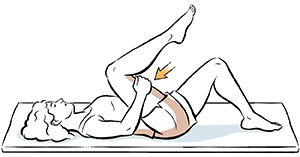Back Care Tips
Caring for your back
These are things you can do to prevent a recurrence of acute back pain and to reduce symptoms from chronic back pain:
-
Stay at a healthy weight. If you are overweight, losing weight will help most types of back pain.
-
Exercise is an important part of recovery from most types of back pain. The muscles behind and in front of the spine support the back. This means strengthening both the back muscles and the belly (abdominal) muscles will provide better support for your spine.
-
Swimming and brisk walking are good overall exercises to improve your fitness level.
-
Practice safe lifting methods (see below).
-
Practice good posture when sitting, standing, and walking. Don't sit for a long time. This puts more stress on the low back than standing or walking.
-
Wear quality shoes with good arch support. Foot and ankle alignment can affect back symptoms. Don't wear high heels.
-
Therapeutic massage can help relax the back muscles without stretching them.
-
During the first 24 to 72 hours after an acute injury or flare-up of chronic back pain, put an ice pack on the painful area for 20 minutes and then remove it for 20 minutes. Do this over a period of 60 to 90 minutes, or several times a day. As a safety precaution, don't use a heating pad at bedtime. Sleeping on a heating pad can lead to skin burns or tissue damage.
-
You can alternate using ice and heat.
Medicines
Talk with your healthcare provider before using medicines, especially if you have other health problems or are taking other medicines.
-
You may use over-the-counter medicines, such as acetaminophen, ibuprofen, or naproxen to control pain, unless your healthcare provider prescribed other pain medicine. Talk with your provider before taking any medicines if you have a long-term (chronic) condition, such as diabetes, liver or kidney disease, stomach ulcers, or digestive bleeding, or are taking blood thinners.
-
Be careful if you are given prescription pain medicines, opioids, or medicine for muscle spasm. They can cause drowsiness, and affect your coordination, reflexes, and judgment. Don't drive or operate heavy machinery while taking these types of medicines. Take prescription pain medicine only as prescribed by your provider.
Lumbar stretch

This simple stretch will help relax muscle spasm and keep your back more limber. If exercise makes your back pain worse, don’t do it.
-
Lie on your back with your knees bent and both feet on the ground.
-
Slowly raise your left knee to your chest as you flatten your low back against the floor. Hold for 5 seconds.
-
Relax and repeat the exercise with your right knee.
-
Do 10 of these exercises for each leg.
Safe lifting method
-
Don’t bend over at the waist to lift an object off the floor. Instead, bend your knees and hips in a squat.
-
Keep your back and head upright
-
Hold the object close to your body, directly in front of you.
-
Straighten your legs to lift the object.
-
Lower the object to the floor in the reverse fashion.
-
If you must slide something across the floor, push it.
Posture tips
Sitting
Sit in chairs with straight backs or low-back support. Keep your knees lower than your hips, with your feet flat on the floor.
When driving, sit up straight. Adjust the seat forward so you are not leaning toward the steering wheel. A small pillow or rolled towel behind your low back may help if you are driving long distances.
Standing
When standing for long periods, shift most of your weight to one leg at a time. Switch legs every few minutes.
Sleeping
The best way to sleep is on your side with your knees bent. Put a low pillow under your head to support your neck in a neutral spine position. Don't use thick pillows that bend your neck to one side. Put a pillow between your legs to further relax your low back. If you sleep on your back, put pillows under your knees to support your legs in a slightly flexed position. Use a firm mattress. If your mattress sags, replace it, or use a 1/2-inch plywood board under the mattress to add support.
Follow-up care
Follow up with your healthcare provider as advised.
If X-rays, a CT scan, or an MRI scan were taken, they may be reviewed by a radiologist. You will be told of any new findings that may affect your care.
Call 911
Call 911 if any of the following occur:
-
Trouble breathing
-
Confusion
-
Very drowsy
-
Fainting or loss of consciousness
-
Very fast or very slow heart rate
-
Loss of bowel or bladder control
When to get medical advice
Call your healthcare provider right away if any of these occur:
-
Pain becomes worse or spreads to your arms or legs
-
Weakness or numbness in 1 or both arms or legs
-
Numbness in the groin area
Online Medical Reviewer:
Raymond Turley Jr PA-C
Online Medical Reviewer:
Tara Novick BSN MSN
Online Medical Reviewer:
Thomas N Joseph MD
Date Last Reviewed:
8/1/2022
© 2000-2024 The StayWell Company, LLC. All rights reserved. This information is not intended as a substitute for professional medical care. Always follow your healthcare professional's instructions.